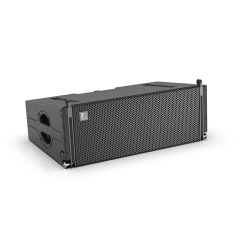Prioir to completing this ribbon tweeter installation we gave you guys an in-depth look at what sets our point source speakers apart from the pack, and identified when and why they're the best choice for clarity. The critical advantage is they can provide a consistent sound field. Point source speaker systems emit sound from a single point — unlike line array speakers which require multiple stacked warping loudspeakers to cover large areas, making sure the emitted sounds are properly phase-aligned. The result is a more transparent, clearer sound that sounds far less processed and artificial than the type of super-directional array used in AVB "beam form" systems... obviously well-suited to installations in which long-throw fidelity across multiple audience areas ranks pretty high on the priority scale.
Point source speakers are also highly efficient. The advantage of these types is that since they are designed to cater for a wide frequency range using one driver, this save space and more importantly eliminates the real challenge in speaker design – fitting multiple components into an acceptable sized cabinet. With this structure, it decreases the complexity of your whole system and possible reduce costs by reducing amplifiers & processors. An example of this is a point source speaker that reproduces 50 Hz to 20 kHz, capable of producing low frequency and high frequencies on its own with quality sound without making it dependent upon another equipment.
Be they ceiling speakers or floor standing models, point source technology leads the way where power handling and dispersion are concerned. Most point source loudspeakers are 300 to 1,200 watts that would cover almost any medium-sized house of worship and dance club or playing venues with consistent SPLs. The 90 – 120 degree coverage pattern spreads sound evenly and efficiently reducing the number of speakers required, while simultaneously eliminating common issues such as overlapping or silent zones.

Where portability and simple deployment are the drivers, point source speakers often lead due to their small form factor and light weight. A single point source speaker can weigh anywhere from 20-50 pounds-- much easier to lug around and install than most large multi-component systems. This is ideal for tours, especially those with a resident band twice a week or more shows need to be assembled and moved off stage quickly. For instance, a live sound engineer can set up and break down a pair of point source speakers for use on something like festival-stage monitor coverage in around 20-25 minutes (room acoustics permitting) from the moment there is sufficient space to start proving them out onward through routing them into an existing audio system.
The point source format also makes them an excellent choice for a wide range of uses, such as live sound reinforcement and fixed installation (theater/rehearsal rooms/houses of worship/meeting rooms). This is a huge plus for consistent sound quality across disparate acoustic environments. On a live stage, for example, point source speakers make it easy to fix vocals and instruments in space without phase issues encountered by non-point-source speaker systems.
Point source boxes such as those installed at London Royal Albert Hall are good examples of how in a very large space high quality sound can be obtained with far fewer speakers. The selection of point source speaker here was, in part due to the options inherit capabilities when it comes to clear non-distorted sound that is heard from greater distances.
Conclusion — Benefits of Point Source•Provides coherent sound delivery for precise imaging and improved intelligibility •Improved efficiency in power handling & coverage, providing higher SPL at the listening position with significantly reduced distortion from input to output.•Portable →Easy Set up-interchangeable within applications. Despite all this tech, the efficiency and ease of use make a point source system one that is viable for anyone looking to get high-quality audio output from their mobile DJ rig.